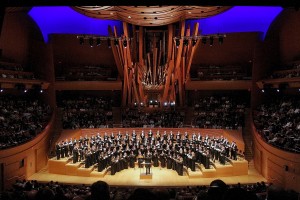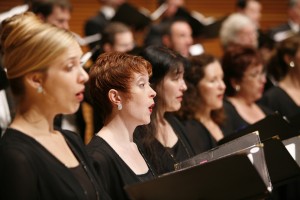LAMC SHINES IN A HISTORICALLY INFORMED PERFORMANCE OF MONTEVERDI’S VESPERS OF 1610
After Los Angeles Master Chorale’s (LAMC) astoundingly successful performance of Claudio Monteverdi’s Vespers of the Blessed Virgin (commonly known as the Vespers of 1610, having been published in that year), I felt the same rejuvenation  and relaxation that would follow a luxuriant all-day health spa retreat. Having never heard the revolutionary and monumental work before, I was astonished that something written in the last decade of Shakespeare’s life could be so sensual. The texts may be sacred, but much of the composition clearly makes use of secular music’”most notably dance; hence, my relaxation from the appropriate solemnity, and my rejuvenation from the modes of music, including Gregorian chant (aka plainsong or plainchant), Renaissance dance, madrigal, and opera (notably, the first opera still to be regularly performed is Monteverdi’s L’Orfeo, composed for the court of Mantua in 1607).
and relaxation that would follow a luxuriant all-day health spa retreat. Having never heard the revolutionary and monumental work before, I was astonished that something written in the last decade of Shakespeare’s life could be so sensual. The texts may be sacred, but much of the composition clearly makes use of secular music’”most notably dance; hence, my relaxation from the appropriate solemnity, and my rejuvenation from the modes of music, including Gregorian chant (aka plainsong or plainchant), Renaissance dance, madrigal, and opera (notably, the first opera still to be regularly performed is Monteverdi’s L’Orfeo, composed for the court of Mantua in 1607).
 The 90-minute Vespers, written for choir, soloists and orchestra, has been recorded and performed in various ways, from scaled-down versions, with soloists as the choir, to monumental, with giant orchestras. At Walt Disney Concert Hall, LAMC joined forces with Musica Angelica Baroque Orchestra, which employed period instruments, to present a “historically informed” performance featuring 40 singers from the Chorale, including soloists Suzanne Anderson and Claire Fedoruk (Sopranos), Janelle DeStefano (Mezzo-Soprano), and Matthew Tresler, Daniel Chaney, and Michael Lichtenauer (Tenors). The Chorale handled Monteverdi’s complexities and cross-rhythms with a rich life-force befitting one of the world’s greatest singing groups.
The 90-minute Vespers, written for choir, soloists and orchestra, has been recorded and performed in various ways, from scaled-down versions, with soloists as the choir, to monumental, with giant orchestras. At Walt Disney Concert Hall, LAMC joined forces with Musica Angelica Baroque Orchestra, which employed period instruments, to present a “historically informed” performance featuring 40 singers from the Chorale, including soloists Suzanne Anderson and Claire Fedoruk (Sopranos), Janelle DeStefano (Mezzo-Soprano), and Matthew Tresler, Daniel Chaney, and Michael Lichtenauer (Tenors). The Chorale handled Monteverdi’s complexities and cross-rhythms with a rich life-force befitting one of the world’s greatest singing groups.
 The orchestra included a string quartet, an enormous lute (which I believe is called a theorbo), a rather petite moveable organ, and six brasses, which include the cornetto (valveless cornet) and sackbut (medieval form of the trombone). While I certainly appreciate the historical integrity, the orchestra was occasionally lost amid the sumptuous power of the chorus. While I have some issues with the unusual blend of the instruments (the organ was practically indistinct), the exquisiteness of Musica Angelica cannot be denied. Still, some of the instruments not only looked cumbersome but sounded a bit unwieldy as well. While they no doubt contributed to the drama of the fully-realized spectacle, and the ear does become accustomed to the accompaniment, I longed for a more a more resounding and dramatic instrumental interpretation.
The orchestra included a string quartet, an enormous lute (which I believe is called a theorbo), a rather petite moveable organ, and six brasses, which include the cornetto (valveless cornet) and sackbut (medieval form of the trombone). While I certainly appreciate the historical integrity, the orchestra was occasionally lost amid the sumptuous power of the chorus. While I have some issues with the unusual blend of the instruments (the organ was practically indistinct), the exquisiteness of Musica Angelica cannot be denied. Still, some of the instruments not only looked cumbersome but sounded a bit unwieldy as well. While they no doubt contributed to the drama of the fully-realized spectacle, and the ear does become accustomed to the accompaniment, I longed for a more a more resounding and dramatic instrumental interpretation.
 The Vespers’ individual sections require various arrangements of the performers, so Music Director Grant Gershon, who led with vitality, made ample use of the space by splitting or seating the chorus, and when two tenor soloists sang a call and response during the “Audi coelom” motet, Gershon placed Chaney downstage and Tresler above the stage alongside a cellist in the loft of the Hall’s colossal organ, creating a delightful echo effect.
The Vespers’ individual sections require various arrangements of the performers, so Music Director Grant Gershon, who led with vitality, made ample use of the space by splitting or seating the chorus, and when two tenor soloists sang a call and response during the “Audi coelom” motet, Gershon placed Chaney downstage and Tresler above the stage alongside a cellist in the loft of the Hall’s colossal organ, creating a delightful echo effect.
At one point, soloist Daniel Chaney inadvertently interrupted the gravity of the event when trying to remember his place on stage’”Chaney was quite effusive in his execution, which occasionally was borderline comical and mildly distracting, but his combination of strength, sweetness and expressiveness in voice made him the standout soloist of the evening. In a strange but endearing way, Chaney mirrored the novel compositional and theatrical techniques employed by Monteverdi. Ms. Anderson and Ms. Fedoruk sang with uncommon clarity and grace, and I loved the way in which Mr. Tresler tenderly and delicately caressed his grace notes during his solo, “Nigra Sum.”
Monteverdi helped lay the foundation for the stylistic conventions of the Baroque period, which extended approximately from 1600’”ten years before the Vespers was written’”to 1750, the year of Bach’s death (and one year after he completed his B Minor Mass). Not only are Monteverdi and Bach bookends to the Baroque era, in which composers used more intricate and extravagant musical ornamentation, but many scholars hold the 90-minute Vespers as the greatest work of sacred music prior to Bach’s Mass.
 There was no intermission, but Mr. Gershon took a break at one point to inform the near-capacity audience that, presumably, Monteverdi intended this daunting collection to be something of a calling card to advertise himself as a master of sacred music’”a sort of audition to land a job with the Pope (Monteverdi did get an appointment as maestro di cappella at St Mark’s Basilica in Venice in 1613, but Rome never offered a post). Whatever his motivations, the spiritually uplifting musical forms based on Biblical texts’”including psalms, motets, a traditional hymn, a sonata, and a superb Magnificat’”contain such a startling inventiveness and diversity that it almost seems criminal the ambitious work fell into obscurity for over 300 years. LAMC is to be commended for illuminating the relevancy of the work, which, by interpolating the “old” and the “new” of its time, has become a composition for the ages.
There was no intermission, but Mr. Gershon took a break at one point to inform the near-capacity audience that, presumably, Monteverdi intended this daunting collection to be something of a calling card to advertise himself as a master of sacred music’”a sort of audition to land a job with the Pope (Monteverdi did get an appointment as maestro di cappella at St Mark’s Basilica in Venice in 1613, but Rome never offered a post). Whatever his motivations, the spiritually uplifting musical forms based on Biblical texts’”including psalms, motets, a traditional hymn, a sonata, and a superb Magnificat’”contain such a startling inventiveness and diversity that it almost seems criminal the ambitious work fell into obscurity for over 300 years. LAMC is to be commended for illuminating the relevancy of the work, which, by interpolating the “old” and the “new” of its time, has become a composition for the ages.
photos by Ken Hively, Lee Salem, and Steve Cohn are not of this concert
Los Angeles Master Chorale with Musica Angelica Baroque Orchestra
Monteverdi’s Vespers of 1610
played Walt Disney Concert Hall on November 18, 2012
for future LAMC shows, call 213-972-7282 or visit http://www.lamc.org


